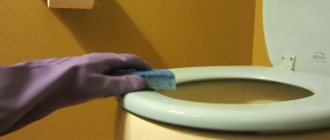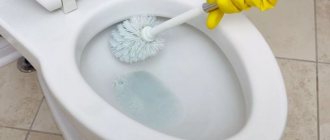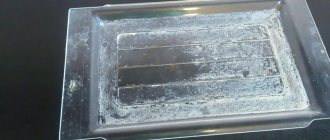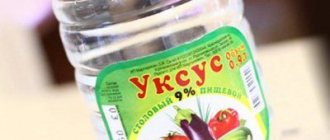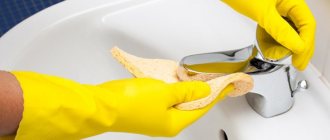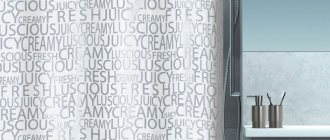The most common problem that almost all owners of shower cabins or an ordinary bathtub with a tap often encounter is the formation of limescale. It can be cleaned with many available means: from baking soda and vinegar to all-purpose cleaners. The only thing: before choosing this or that product, it is recommended to take into account the properties of the materials from which the shower tray itself and its doors are made, so as not to disturb the entire aesthetics of the appearance and preserve their original brightness and shine. In the materials of the presented review, we will consider in more detail how to clean a shower stall from limescale, and what the most effective cleaning products exist.
Subtleties of the process
Limescale is a mixture of calcium and iron salts that periodically appears on the surfaces of the shower stall after the water dries. A cloudy film that spoils the appearance is also caused by the residues of cleaning and detergent compounds. Washing a shower stall is not an easy process, since it has a rather complex design solution. Every part of it - walls, door, handles, tray, shower heads - must be cleaned regularly.
The salt residue should be disposed of correctly. What is the best way to clean limescale in order to preserve the beauty of modern materials? This question often causes difficulties for many. But don't be afraid. There are many options for cleaning products and detergent formulations to combat this problem. You just need to subject each of them to careful study. Only then can you start cleaning.
There are three types of shower device care.
- Current. This is done after every shower. It consists of rinsing the internal surfaces first with hot and then with cold water, then wiping them thoroughly.
- Basic. The frequency of execution is from 1 week to 1 month. Includes cleaning with detergents, rinsing and wiping dry.
- Intensive. This is carried out using strong chemicals in case of prolonged downtime of the cabin without use or in case of old plaque.
Without proper regular maintenance of your shower stall, cleaning it will become more and more difficult each time. And at some point you will realize that it is not possible to remove all the pollution.
As a result, washing this plumbing structure must be approached with all responsibility. Cleaning must be systematic and thorough. Only then will the shower stall delight you with its impeccable appearance and high level of performance.
Remember that shower devices may vary. Some models have plastic walls, while others are made of glass. There are also designs that are simply attached to the walls of the bathroom. First of all, find out what type of shower stall you have, and what surface materials will need cleaning. The choice of cleaning products will largely depend on this.
In addition, do not forget that the warmth and dampness of the bathroom are ideal conditions for the appearance of mold. And black mold is not only unsightly - it poses a real health hazard. Careful maintenance of order and periodic ventilation are suitable as preventive measures.
Let's consider an approximate procedure for cleaning a shower device:
- We remove bath accessories;
- wet all surfaces with water;
- apply selected household chemicals, wait the required time;
- rinse;
- remove water using a soft scraper;
- wipe all elements dry with a cloth;
- We treat all parts with glass cleaning composition to add shine.
Bathroom cleaning trick
After washing, spread a small amount of glass cleaning spray onto a clean surface. The product contains ammonia, which neutralizes barely noticeable limescale deposits. The spray should be washed off after 20-30 minutes.
A large bathtub can be cleaned in 5-15 minutes with industrial gels - it’s quick, but labor-intensive. Gentle products should be left on the walls - while the lime acidifies, you have time to rest or do other things, just don’t forget to close the door to the bathroom and warn your household that it is not yet possible to pour water into the bathing container.
A clean bathroom is necessary not only for comfort, but also for maintaining health. The lime layer can be easily removed if you do not let the situation take its course and rinse after each use. Fighting limescale build-up won’t take much time either, the main thing is to choose the right product.
Folk remedies
Before spending money on expensive household chemicals, take a closer look at safe and more natural folk methods. The superiority of this method compared to chemistry, including their environmental friendliness, is that they do not require large expenses and some of the necessary components are almost always found in the house.
Lemon solution
Citric acid removes rust and plaque quite well. To cleanse the shower with acid or lemon juice, you need to make a special solution according to this recipe:
- dilute a packet of acid or lemon juice in half a glass of water;
- pour the solution into a spray bottle;
- Spray evenly over the entire surface of the cabin.
After softening the dirt for 10 minutes, rinse it all off with cool water. If after these steps the plaque still remains, then it is necessary to increase the proportions of the acid solution and add a couple of lemons or a whole package of acid to the same amount of water.
Lemon acid
Works great on both greasy and limescale stains. To work, you will need 100 g of citric acid and 500 ml of clean water.
Instructions:
- Stir the crystals in warm water.
- Spread the solution over the white layers.
- Leave for 15 minutes.
- Wipe with light pressure with a sponge or cloth.
- Rinse off with running water.
- Wipe dry.
Advice If there is a lemon in the refrigerator, do not rush to throw it away. If there is still juice left in it, wipe the chrome parts of the plumbing with it - they will shine without any chemicals.
Toothpaste
Tooth powder is considered an effective surface cleanser.
However, it is better to use toothpaste for the shower, since it does not contain abrasive particles that can damage the smooth surface.
To treat the surface, simply apply the product to problem areas and rub with a loofah. For difficult to remove dirt, apply the paste and leave it for a while, and then remove with a sponge.
Baking soda and hydrogen peroxide
This pair does an excellent job of removing newly formed mold in the corners of the cabin and tarnish. Sprinkle baking soda on the contaminated area and wait half an hour. Then you need to rub the area with a sponge, pour soda with peroxide and leave to dry.
Vinegar solution and ammonia
To clean the shower from all types of plaque using vinegar, dissolve it in water in a ratio of 1: 1. Pour this mixture over the area to be treated for half an hour, then rinse everything with cold water.
Ammonia brilliantly removes soap stains.
The product is used specifically on stains, but for a greater cleaning effect it should be used together with soda or vinegar.
For a recipe for old dirt, you will need a mixture of half a glass of ammonia, 2 liters of water and a tablespoon of soda and vinegar.
Liquids containing alcohol
Ethyl alcohol is most effective in cleaning glass surfaces from limescale. For the cleaning composition, you need to dilute vodka or alcohol with water in a ratio of 1: 2. In addition to glass, this solution also perfectly cleans chrome-plated appliances.
Soap
And for daily cleaning of acrylic, it is enough to wash it with a sponge and soap after use. This will prevent plaque and rust from occurring. To get rid of grease, you can use dishwashing liquid.
Vodka+water
Another way to clean shower glass until it shines is to use vodka and water. You need to take 2 tbsp. l. alcohol per 2 tbsp. l. water, and treat the door with the resulting solution.
Coca-cola
This carbonated drink has long been known as a folk remedy that is effective in removing limescale and rust. To clean the surface of the shower, you need to pour cola on the area being treated, wait half an hour and rinse thoroughly with cool water.
It is very easy to clean off limescale using recommended folk remedies. Such solutions are much cheaper and will be quite effective.
To learn how to achieve crystal cleanliness and whiteness in your shower stall in 5 minutes, see below.
Note to the hostess
- A restored bathtub can be compared to an acrylic one - it requires careful care.
- If you do clean with a powder, never pour it directly into an empty bathtub. Wet the surface, fill the bath with some water, and only then start cleaning.
- In the bathroom you also need to take care of the shower. Regularly remove the shower head and rinse the inside with acetic acid.
- Add a little “Whiteness” to your bath cleaner. This way the product will more effectively clean the surface of water stone.
- An excellent product for cleaning metal taps is ammonia. Simply rub it onto the metal, leave it on for 10 minutes, and then rinse off.
- If there is no citric acid, you can squeeze the juice from the lemon and wipe the contaminated surface with it.
- For disinfection, which should be carried out regularly, 250 ml of “Whiteness” is poured into a bathtub filled with water. This helps to both disinfect and at the same time whiten the coating.
- Cast iron can be easily washed with a mixture of table salt and vinegar, which is applied with a sponge for a few minutes.
There are many options for how to clean a bathtub from lime without pain. Choose your method and keep your bathroom sterile, not forgetting about mirrors, shower and shelves.
The most popular store-bought cleaners
Choosing effective cleaning products for your shower stall is not an easy task. Your eyes just run wild when you have to choose one thing. But, nevertheless, there are time-tested products that have proven themselves on the positive side, such as:
- Dishwashing detergents - effectively remove traces of soap scum. In addition to liquid formulations, in some cases “Komet”, “Pemolux” and other powders are acceptable.
- So-called fungicides - to remove black plaque and mold.
- To treat toilets - they can help clean, for example, the Toilet Duck stone tray can be a lifesaver for those who have very hard water.
- To combat scale in teapots. Antiscale solution will help get rid of limescale.
- Cleaning products for mirrors and glass. It doesn’t matter what it will be - “Mr. Muscle” or some other composition.
- Melamine sponge. This is an almost universal product that can effectively remove dirt.
Popular detergents that can be used to clean the hydrobox:
- "Akrilan" is a special product designed for cleaning acrylic surfaces.
- Cilit is a powerful product that should not be used on natural stone or aluminum surfaces. Quite poisonous. Requires extreme caution in handling.
- Tilex is a prophylactic agent. Used after taking a shower to prevent the formation of plaque and mold.
- Cif is a well-proven remedy. Can clean acrylic surfaces.
- “Sanelit” has a pungent odor, but at the same time copes well with the assigned tasks. Suitable for cleaning acrylic.
- Aron – effectively cleans hydrobox glass.
- Sarma, Domestos, OC Plus.
Metal
On metal surfaces, such as taps, hooks or bathtub elements, limescale can be removed with regular dishwashing detergent. The concentrated product is applied to the surface, which is then cleaned with a sponge or brush. After cleaning, the product is washed off. If the contamination is very strong and the limescale deposits are very coarse, then you can use special compounds for cleaning plumbing fixtures. Experienced housewives buy plumbing cleaning creams that remove stone well and do not scratch metal.
Safety regulations
When working with cleaning products, you must follow safety rules: wear rubber gloves. When spraying or applying, do not close yourself inside the shower stall. Is it dangerous!
- When choosing a particular cleansing product, you need to pay attention to its safety. The best option would be that it has no odor and contains environmentally friendly ingredients. Please read the instructions carefully before cleaning.
- Before using special equipment, you need to let a lot of steam into the shower stall. This can be done by simply opening a tap with hot water (but not boiling water!). Hot steam will soften limescale deposits, making further cleaning much easier.
Important! The ideal option is to use a steam generator! The device will make it much easier and faster to clean limescale deposits and also kill bacteria.
Method 7: Cleaning Plumbing and Pipes with Vinegar
When plaque covers chrome surfaces, table vinegar comes to the rescue:
- Dilute vinegar with warm water in equal proportions.
- Moisten a piece of cloth with the solution and cover the tap with it, securing with an elastic band if necessary.
- Leave for 2-4 hours.
- Removable items should be soaked in the solution for half an hour.
- Rinse with clean water, removing any loose deposits with a piece of cloth.
- Wipe dry.
spring-cleaning
Once every 10–14 days, you should thoroughly clean the shower stall to remove various contaminants. General cleaning should be carried out in cases where the structure has not been used for a long time, for example, you were away.
General cleaning is carried out in several main stages:
- Cleaning walls and plastic elements. Get rid of lime deposits and other types of dirt. To do this, apply the selected product to the surface, leave for a while and rinse with clean water. When cleaning walls, pay special attention to the seams between tiles, as this is a favorite place for mold to grow.
- Washing glass doors. Wash the glass thoroughly to remove soap stains. Special sprays for windows and glass will cope well with this task. A solution of vinegar, citric acid or ammonia is also suitable. Use the product according to the instructions, then wipe dry with a soft cloth.
- Cleaning chrome elements. Thoroughly clean the mixer, hydromassage head and other elements from mineral salts. Using purchased or folk remedies, restore their attractive shine.
- Washing the tray. At the last stage, you need to wash the tray. When choosing a detergent, consider the material from which it is made. For example, for acrylic pallets it is strictly forbidden to use compounds containing formaldehyde or formic acid. Enameled pallets are more resistant to chemicals, but it is better to avoid abrasives.
When you go to do general cleaning in the shower stall, arm yourself with the following tools and devices:
- soft rags and microfiber;
- spray bottle;
- rubber scraper;
- foam sponge;
- toothbrush.
Removing limescale from the shower stall - video:
The use of hard brushes and metal scrapers is prohibited as they may leave scratches.
If old stains cannot be removed using traditional methods, use a steam cleaner. No dirt can resist the pressure of hot steam.
Preventive measures
To avoid the formation of plaque on the surfaces of sinks and faucets, you need to respond to the problem in a timely manner. Ideally, do preventative cleaning of plumbing fixtures. It consists of a few simple steps:
- Wash your sink weekly using liquid soap or dish gel. It is allowed to add soda or citric acid;
- Rinse the surface daily if foam or soap remains after use;
- treat the sink with chlorine-containing products twice a week; even regular white will do;
- purchase a water filter and install it on the incoming line, it will soften the water and eliminate heavy salts.
Preventive sink care Source dugulaselharitas-mester.hu
On a note! Remember the safety precautions. When using chemicals to clean sinks, do not ignore a respirator and rubber gloves. They will prevent burns to the mucous membranes and skin of the hands.
How to care for your shower cabin during use
The higher the water hardness, the faster limescale appears on the hydrobox parts after it evaporates. Stains and white deposits quickly eat into materials; it is important to remove any stains that appear on a daily basis.
You need to wash off the soap suds, remove remaining water with a rubber scraper, and wipe all parts dry.
Leave the cabin open - this will allow moisture to evaporate faster.
Do not leave water in seams and corners; in hard-to-reach places most microbes arise, mold and mildew form. This is harmful to health and is more difficult to remove than ordinary limescale.
How to prevent plaque from appearing
Only daily cleaning will help prevent the appearance of lime deposits in the toilet, sinks and kitchen:
- Dinnerware and sinks always get dirty with food and grease residue that causes dirt to build up. Therefore, they are washed regularly.
- Constantly leaking water from a tap or barrel leaves a yellow coating over time. Therefore, it is necessary to configure the drain correctly.
- The toilet should be cleaned with a brush after each use.
What products can harm the cabin?
Before purchasing, read the instructions for the shower. It contains care tips and lists substances that should not be used when cleaning.
If the instructions do not provide such information, make sure that the products do not contain aggressive chemicals: formic and oxalic acids, formaldehyde, acetone, abrasive particles, etc.
Do not use hard sponges, metal brushes, or scrapers with sharp edges.
To clean the shower stall from plaque, you need to promptly deal with lime stains and scale, do not use products with aggressive substances, abrasive compounds, and take into account the characteristics of the materials. Such measures will extend the life of the plumbing fixtures.
Causes of toilet contamination
Limescale is also sometimes called waterstone; it is formed as a result of the deposition of salts contained in tap water.
As a rule, the yellowish coating is located precisely in the areas where the water is flushed, but sometimes it can be seen under the rim of the toilet bowl and on the lid. Without proper care of your plumbing, the limescale layer gradually builds up, making it difficult to remove. In addition to the toilet, you should periodically clean the bathtub and shower stall to remove this deposit.
Cleaning the toilet takes a couple of minutes a day
Urinary stones are made up of mineral components that are found in human urine. Deposits begin to form when residents regularly forget to flush the toilet. Another problem is rust - rusty stains also form in places where water is flushed.
In addition, other reasons for the appearance of deposits in the toilet can be noted:
- high concentration of salts in water;
- the presence of cracks and other damage on the walls of plumbing fixtures;
- faulty barrel.
Attention! Despite the fact that water and organic stones spoil the appearance of plumbing fixtures, deposits are an excellent breeding ground for microorganisms.
You can cope with this problem at home using available means. In difficult cases, when there is too much contamination, you will have to use chemicals.
To wash plumbing fixtures, you need to purchase thick gloves.
What to rub on faucets to make water run off?
If you find it, write.
I use “steel shine”... it clearly lasts longer, they shine for a couple of days without strain


